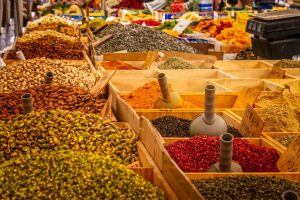12 delicious Moroccan spices
Saffron (Zafrane)
When it comes to cookery, saffron is certainly a global phenomenon. The majority of the world’s saffron supply comes from just a few countries, including Morocco. This being stated, you can expect to find these Moroccan spices at relatively low prices!
Saffron, despite having a distinct flavor, is difficult to express in words. It’s gently sweet and flamboyant; a small bit of it instantly adds flavor, vitality, and perfume to a dish.
Saffron complements practically every dish, from bouillabaisse to pudding. If you want to keep using it as a real Moroccan spice, consider making Moroccan saffron chicken.
Ras el Hanout
If you want to bring Moroccan flavors home with you, ras el hanout is your best chance. This spice brings out the finest in Moroccan spices—made it’s up of over a dozen of them! Cardamom, cinnamon, turmeric, chili peppers, and nutmeg are all common ingredients in ras el hanout.
Ras el hanout is not widely available due to its complexity. But, without a doubt, Morocco is the location to start looking for this spice. Please keep in mind that each blend tastes somewhat different, so shop around before you buy!
Ras el hanout, like saffron, is a specialty spice. It is commonly used in finer traditional recipes such as Grazia, tajine, and couscous tray.
Black pepper (Ibzar or elbezar)
Black pepper needs less explanation because it is far more widespread than the preceding Moroccan spices. However, it is worth noting that Moroccan cuisine liberally employs black pepper. Most Moroccan meals contain substantial amounts of black pepper. Moroccans typically use black pepper to season meat (particularly lamb tagines) or salads.
Turmeric (Kharkoum or queue)
Nothing adds more color to the cuisine than turmeric. Turmeric is widely used in Moroccan cuisine due to its distinctive yellow color. It adds an earthy and unusual flavor to foods. Meat Tagine with Prunes and Chicken and Olives Tagine are two famous Moroccan recipes that incorporate turmeric.
Turmeric, sometimes known as golden saffron, offers more than simply flavor and color. This Moroccan spice is well-known for its health benefits: it acts as a natural anti-inflammatory and antioxidant, as well as strengthening numerous biological systems.
Fenugreek seeds (Helba or halba)
Fenugreek seeds, known for their pungent aroma and flavor, are widely used in Moroccan chicken dishes. The herb itself has a sweet flavor, but the bitter seeds are commonly used in Moroccan cuisine to lend character to a dish.
Fenugreek is well-known for its health advantages, which include decreasing blood sugar and cholesterol levels, as well as increasing testosterone. It also promotes lactation. Nursing women in Morocco turn to foods with this spice to help them breastfeed their newborns.
Cumin (Kamoun or kimono)
Cumin, which is pungent and aromatic, adds a strong flavor to any Moroccan meal. Moroccans use this spice as a seasoning since it combines well. Locals typically add cumin to their eggs, tagines, barbecues, and salads—but only when they want a certain result. Kefta Brochettes is a famous Moroccan meal that includes cumin.
As cumin became more popular, people began using it to treat stomach and diarrhea. Cumin has also been shown to improve immunity due to its high quantities of vitamin C, iron, and fiber.
Ginger (Skinjbir)
Another potent component, ginger spice, is commonly used in Moroccan tagines, stews, and soups. Ginger, whether crushed or powdered, has numerous health benefits: To say the least, it has anti-inflammatory and antioxidant effects.
Cinnamon (Karfa)
Cinnamon has unquestionably created a reputation for itself in the global marketplace. It has become a popular addition to fashionable beverages and desserts all around the world. However, cinnamon has been utilized in Morocco since time immemorial. In truth, ancient Moroccans traded cinnamon because it was—and still is—a valuable spice with a high price.
Aside from sweet foods, Moroccan meat-based cuisines also highlight the sweet and woody flavor of cinnamon. This spice is also used in various traditional soups, such as harira.
Anise seed (Nnafaâ or naff)
With a licorice-like flavor, anise seed is typically used in Moroccan desserts such as ravens, cookies, and bread. This spice is also used in several soup and tagine recipes to give a kick.
Anise seed, like many Moroccan spices, has several health advantages. It is yet another anti-inflammatory; it also has antifungal and antibacterial properties. Above all, anise seed is abundant in calcium. This strengthens bones while also empowering nerves and muscles.
Paprika (Felfla hlouwa)
In Morocco, paprika refers to a sweet product made from crushed dried bell peppers. Cayenne pepper is the name given to the hotter cousin of hot paprika. Moroccans enjoy using sweet paprika in a variety of cuisines. It provides acidity and color to salads, stews, and soups, and it’s also used to season meat dishes.
Cayenne (Felfa sudaniya)
Cayenne pepper is one of the spices in Morocco that distinguishes most cuisines. Its strong peppery flavor instantly elevates a cuisine, but its rather delicate flavor allows for its versatility. Most Moroccan cuisines include cayenne pepper as an optional ingredient. Moroccans frequently mix this spice with its sweet counterpart, paprika.
Nutmeg (Bsibsa)
Nutmeg has a unique role in Moroccan cuisine. It is often found in seasonal foods, but you can always add it to stew, couscous, or tagine. Because of its sweet and nutty flavor, this spice is commonly used in desserts, either as an ingredient or as a garnish. Moroccans rarely use nutmeg to season meat meals.
How to Serve a Moroccan Meal
Now that you have your spices, the following step is to figure out how to use them. As an appetizer, try a famous Moroccan couscous recipe. Moroccans traditionally consume beef, lamb, or chicken. (Pork is unpopular because it contradicts religious beliefs.)
If you’re feeling daring, try making a tagine. Don’t have a tagine? You can rely on your Dutch oven/slow cooker/instant pot to get the job done!
If you want to play it safe, go for a good old grill or roast. Season your meat with the correct spices, and you’ll have an authentic Moroccan dinner in no time!
Remember to serve a salad before the main entrée. Lemon juice, tomatoes, pomegranate, cilantro, and boiled eggs are all common ingredients in Moroccan salads. Mix with your seasonings and you’re done!
Moroccan spice shopping
Aside from those stated in this Moroccan spices list, the Moroccan spice market has a plethora of other intriguing flavors and herbs. Make careful to arm yourself for battle: Bring a resealable bag for the spice packs you’ll be bringing home with you!
If you like spontaneous adventures, you’ll love the Moroccan spice market. Moroccan bazaars are famed for their shabby chic appearance; every visit is an adventure! However, while unpredictability is wonderful, don’t go to the market unprepared. Carry out your research! Know where the best and most cheap things are so you don’t end up walking in circles.
Most Moroccan bazaars close at night, so pay attention to the hours they are open as well. End-of-day shopping may also be beneficial since some vendors reduce their prices before the day ends.
So there you have it! That’s all there is to know about Moroccan spices. Have fun cooking!



